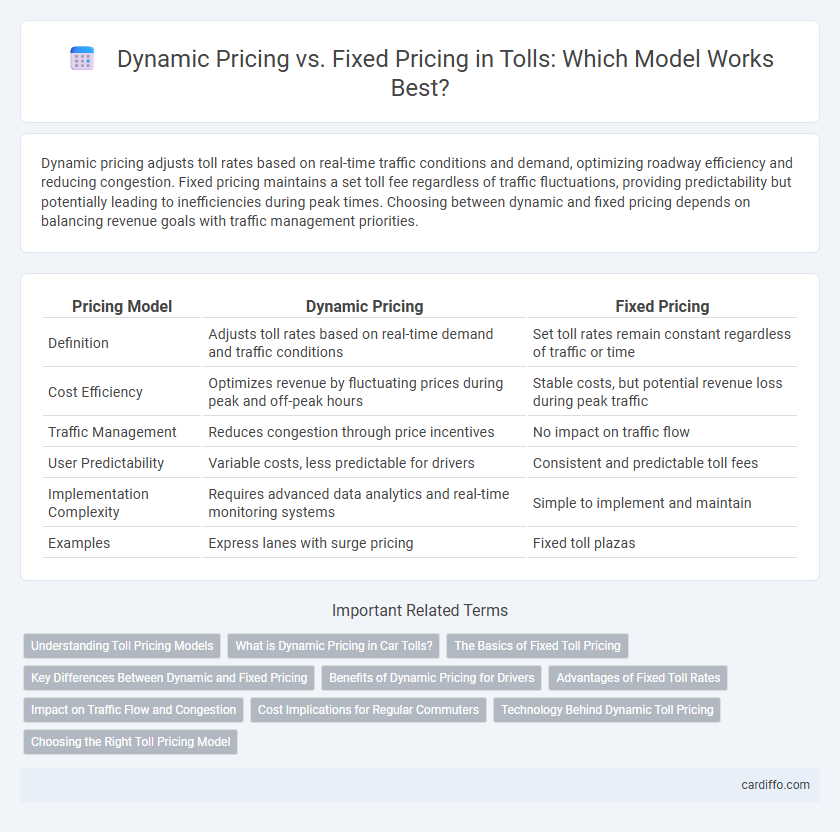Dynamic pricing adjusts toll rates based on real-time traffic conditions and demand, optimizing roadway efficiency and reducing congestion. Fixed pricing maintains a set toll fee regardless of traffic fluctuations, providing predictability but potentially leading to inefficiencies during peak times. Choosing between dynamic and fixed pricing depends on balancing revenue goals with traffic management priorities.
Table of Comparison
| Pricing Model | Dynamic Pricing | Fixed Pricing |
|---|---|---|
| Definition | Adjusts toll rates based on real-time demand and traffic conditions | Set toll rates remain constant regardless of traffic or time |
| Cost Efficiency | Optimizes revenue by fluctuating prices during peak and off-peak hours | Stable costs, but potential revenue loss during peak traffic |
| Traffic Management | Reduces congestion through price incentives | No impact on traffic flow |
| User Predictability | Variable costs, less predictable for drivers | Consistent and predictable toll fees |
| Implementation Complexity | Requires advanced data analytics and real-time monitoring systems | Simple to implement and maintain |
| Examples | Express lanes with surge pricing | Fixed toll plazas |
Understanding Toll Pricing Models
Toll pricing models vary between dynamic and fixed pricing, where dynamic pricing adjusts toll rates based on real-time traffic conditions, demand, or time of day to manage congestion and optimize revenue. Fixed pricing maintains a constant toll rate regardless of traffic fluctuations, simplifying budgeting for drivers but reducing flexibility in traffic management. Understanding these models helps transportation authorities balance infrastructure funding with efficient roadway usage and user satisfaction.
What is Dynamic Pricing in Car Tolls?
Dynamic pricing in car tolls adjusts toll rates based on real-time traffic conditions, time of day, and demand patterns to optimize road usage and reduce congestion. This variable pricing model incentivizes drivers to travel during off-peak hours by lowering toll fees, thereby improving overall traffic flow on toll roads and express lanes. Advanced technologies such as electronic toll collection systems and traffic sensors enable accurate and efficient implementation of dynamic toll pricing strategies.
The Basics of Fixed Toll Pricing
Fixed toll pricing establishes a set fee for road usage regardless of traffic conditions, time of day, or vehicle type, providing predictable costs for drivers and straightforward revenue forecasting for toll operators. This static pricing model simplifies toll collection systems and reduces administrative overhead compared to dynamic pricing, which adjusts rates based on demand and congestion levels. Fixed toll pricing is commonly used on highways and bridges where consistent traffic patterns allow for stable pricing strategies that support infrastructure maintenance and operational funding.
Key Differences Between Dynamic and Fixed Pricing
Dynamic pricing adjusts toll rates in real-time based on traffic demand, congestion levels, and time of day, optimizing revenue and managing traffic flow effectively. Fixed pricing maintains a constant toll rate regardless of fluctuations in traffic volume, providing predictability but potentially causing congestion during peak hours. The key difference lies in responsiveness: dynamic pricing offers flexibility to balance demand and supply, while fixed pricing ensures consistent charges but may reduce efficiency in traffic management.
Benefits of Dynamic Pricing for Drivers
Dynamic pricing for tolls offers drivers the benefit of reduced congestion by adjusting fees based on real-time traffic conditions, enabling faster travel times. This pricing model incentivizes off-peak travel, leading to lower toll costs for drivers who choose less crowded routes or times. Dynamic pricing enhances overall road efficiency and provides cost savings opportunities compared to fixed pricing's static fees.
Advantages of Fixed Toll Rates
Fixed toll rates provide predictable revenue streams that facilitate consistent infrastructure funding and budget planning for transportation authorities. They eliminate traveler confusion and reduce administrative costs by maintaining stable, simple pricing structures without the need for real-time adjustments. Fixed pricing also ensures fairness and equity, preventing fluctuations that may disproportionately impact certain driver groups during peak times.
Impact on Traffic Flow and Congestion
Dynamic pricing adjusts toll rates in real-time based on traffic demand, effectively managing congestion by encouraging off-peak travel and reducing bottlenecks. Fixed pricing maintains a constant toll rate, which often leads to predictable traffic patterns but can exacerbate congestion during peak hours due to lack of demand-based incentives. Studies indicate that dynamic pricing improves traffic flow efficiency and decreases overall travel time compared to fixed pricing models.
Cost Implications for Regular Commuters
Dynamic pricing for tolls can lead to fluctuating travel costs, often increasing during peak hours, which may burden regular commuters with unpredictable expenses. Fixed pricing offers consistent toll fees, allowing commuters to budget effectively without unexpected cost spikes. Evaluating cost implications highlights that regular users might save money with predictable fixed rates, while dynamic pricing maximizes revenue but reduces financial certainty for daily travelers.
Technology Behind Dynamic Toll Pricing
Dynamic toll pricing leverages advanced technologies such as real-time traffic sensors, GPS data analytics, and machine learning algorithms to adjust toll rates based on current traffic conditions and congestion levels. These systems collect vast amounts of data through interconnected IoT devices and employ predictive modeling to optimize price fluctuations, aiming to alleviate traffic bottlenecks and improve flow. Cloud-based platforms enable seamless data processing and instant rate adjustments, ensuring efficient toll management and dynamic revenue optimization.
Choosing the Right Toll Pricing Model
Selecting the optimal toll pricing model involves evaluating traffic patterns, revenue objectives, and user experience goals. Dynamic pricing adjusts toll rates based on real-time demand, effectively managing congestion and maximizing revenue during peak hours. Fixed pricing offers predictability and simplicity, appealing to drivers seeking consistent costs without fluctuations.
Dynamic Pricing vs Fixed Pricing Infographic

 cardiffo.com
cardiffo.com